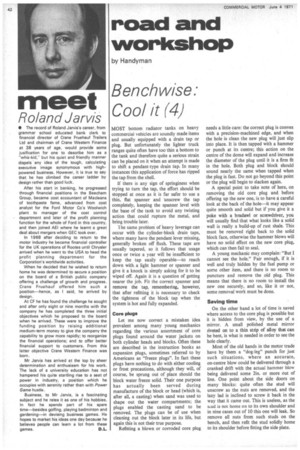road and workshop
Page 44

If you've noticed an error in this article please click here to report it so we can fix it.
by Handyman
Bench wise: Cool it (4)
MOST bottom radiator tanks on heavy commercial vehicles are soundly made items and usually equipped with a drain tap or plug. But unfortunately the lighter truck ranges quite often have too thin a bottom to the tank and therefore quite a serious strain can be placed on it when an attempt is made to shift a pendant-type drain tap. In many instances this application of force has ripped the tap from the shell.
If there is any sign of springiness when trying to turn the tap, the effort should be stopped at once as it is far safer to use a thin, flat spanner and unscrew the tap completely, keeping the spanner level with the base of the tank to avoid any twisting action that could rupture the metal, and bring trouble later.
The same problem of heavy leverage can occur with the cylinder-block drain taps, Where many have the pendant lever missing, generally broken off flush. These taps are usually tapered, so it follows that usage once or twice a year will be insufficient to keep the tap easily operable—to reach down with a light hammer or spanner and give it a knock is simply asking for it to be wiped off. Again it is a question of getting nearer the job. Fit the correct spanner and remove the tap, remembering, however, that after refitting it is necessary to check the tightness of the block tap when the system is hot and fully expanded.
Core plugs Let me now correct a mistaken idea prevalent among many young mechanics regarding the various assortment of core plugs found around the water jackets on both cylinder heads and blocks. Often these are described in the instruction books as expansion plugs, sometimes referred to by Americans as "freeze plugs". In fact these plugs have nothing to do with either cooling or frost precautions, although they will, of course, be sprung out of place should the block water freeze solid. Their one purpose has actually been served during manufacture of the block or head (which is, after all, a casting) when sand was used to shape out the water compartments; the plugs enabled the casting sand to be removed. The plugs can be of use when cleaning out the block later in its life, but again this is not their true purpose.
Refitting a blown or corroded core plug needs a little care: the correct plug is convex with a precision-machined edge, and when the hole is clean the new plug will just slip into place. It is then tapped with a hammer or punch at its centre; this action on the centre of the dome will expand and increase the diameter of the plug until it is a firm fit in the hole. Both plug and block should sound nearly the same when tapped when the plug is fast. Do not go beyond this point or the plug will begin to slacken again.
A special point to take note of here, on removing the old core plug and before offering up the new one, is to have a careful look at the back of the hole—it may appear quite smooth and solid but if you give it a poke with a bradawl or screwdriver, you will usually find that what looks like a solid wall is really a build-up of rust shale. This must be removed right back to the solid block face, otherwise the hammer blows will have no solid effect on the new core plug, which can then fail to seal.
A young mechanic may complain: "But I cannot see the hole." Fair enough, if it is well and truly hidden by the fuel pump or some other item, and there is no room to puncture and remove the old plug. This means that there is no room to install the new one securely, and so, like it or not, some removal work must be done.
Saving time On the other hand a lot of time is saved where access to the core plug is possible but it is hidden from view, by the use of a mirror. A small polished metal mirror riveted on to a thin strip of alloy that can be bent, is what is needed in order to see the hole clearly.
Most of the old hands in the motor trade have by them a "dog-leg" punch for just such situations, where an accurate, on-centre blow could be delivered through a cranked drift with the actual hammer blow being delivered some 2in. or more out of line. One point about the side doors on many blocks: quite often the stud will unscrew as the nuts are removed, and the lazy lad is inclined to screw it back in the way that it came out. This is useless, as the sLud is not home on to its own shoulder and in nine cases out of 10 this one will leak. So remove all nuts from such studs on the bench, and then refit the stud solidly home to its shoulder before fitting the side plate.
































































































